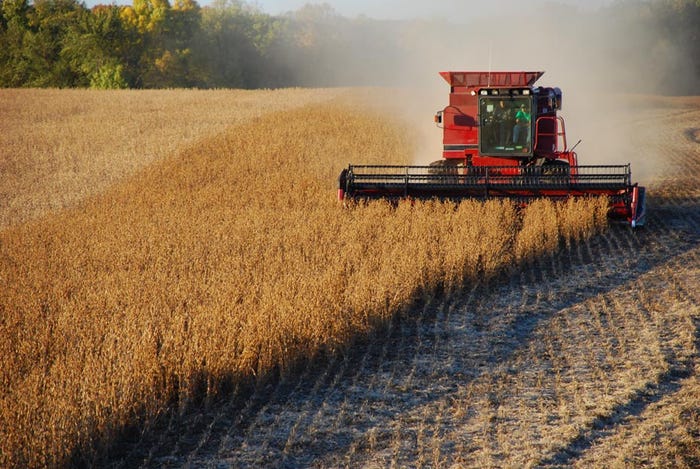November 20, 2018

A study was conducted in the Midwest to assess the influence of row spacing on soybean yield using experimental and producer survey data. The researchers developed an approach to evaluate the influence of row spacing on U.S. soybean yield using both producer and experimental data.
The experimental data showed a consistent yield advantage of narrow versus wide row spacing. However, data from producer fields indicate no yield difference between narrow and wide rows.
This complementary approach can help evaluate yield increase derived from a management practice.
Analysis of data from controlled experimental trials conducted across a wide range of environments in the U.S. soybean producing region revealed a positive NR-WR yield difference in 76% of the paired comparisons, with NR yield averaging 7% more than WR yield across all observations. In two of the three U.S. regions, magnitude of NR-WR yield difference was strongly associated with length of emergence to pod-setting phase, indicating that NR can serve as a ‘rescue treatment’ in situations in which the crop vegetative phase is expected to be shortened to the degree that full canopy closure cannot be achieved in WR prior to, or during, the critical period for yield determination in soybean (i.e., from initiation of pod-setting [R3] to beginning of seed filling
[R5]). Such situations typically occur when the sowing date is delayed and/or when early maturity group cultivars are used. In contrast, NR-WR yield difference was negligible in experiments sown early with a full-season cultivar.
The NR-WR yield difference was smaller and less consistent for the experiments located in the central U.S. region. This is of particular interest as this region accounts for 61% of total U.S. soybean production (USDA-NASS, 2017). We speculate that favorable temperature and water balance during this two-decade set of recent experimental trials, together with deep soils with high available soil water at sowing, favored canopy closure by R3 in soybean crops in the central region irrespective of row spacing. Furthermore, NR soybean crops are typi cally more susceptible to greater disease pressure, especially in wet seasons (e.g., white mold Sclerotinia sclerotiorum; Willbur et al., 2018). Consistent with this hypothesis, July total rainfall was higher in the group of experimental trials exhibiting a negative NR-WR yield difference in the central region relative to those trials with largest NR-WR yield difference (t-test,p<0.05).
We could not detect a consistent NR-WR yield difference based on producer soybean field data collected across 39 major climate-soil-water regime domains in the North Central U.S. region where soybean is grown. In fact, there was evidence of yield penalty due to NR in 30% of these domains. The lack of NR-WR yield differences in producer fields calculated for the TEDs located within the central region were consistent with the very small NR-WR yield difference found for the same region using the experimental data. Conversely, the lack of NR-WR yield difference in producer fields in TEDs located in the northern region conflicted with the large yield difference detected in the north region using experimental data. We note that performing the same comparison for the south region was not possible because no survey data were available for this region, where NR is most likely to be beneficial as indicated by analysis of the experimental data. We speculate that the lack of yield benefit derived from NR in producer fields may be associated with other management practices that may lessen or mask the NR yield advantage. In addition, a yield penalty of 1-5% is expected in NR crops as a consequence of wheel track damage caused when spraying canopy fungicide during reproductive stages (Hanna et al., 2008; Holshouser and Taylor, 2008). Sprayer wheel-track induced yield loss usually does not occur in controlled experiments. Finally, we note that despite the small and inconsistent yield benefit associated with NR, other factors can still justify adoption of NR (e.g., soil erosion control, better weed control).
Small, or even nil or negative, NR-WR yield differences may have limited NR adoption in the central region, especially in irrigated fields (Fig. 3). Another possible explanation is the high cost of purchasing a split-row planter, which would require an extra bushel a-1 y-1 to match the investment (De Bruin and Pedersen, 2008). Note this calculation is based on a 740 ac farm with 30% 9 soybean sown area and using average (2014-2018) soybean price of $11 bu-1. Given extra cost of the planter and sprayer-wheel track damage, the mean NR-WR yield difference calculated in the south and north regions based on the experimental data would still justify adoption of narrow rows, but it would be less acceptable (financially) to producers in the central U.S. region, especially for producers already following other best management practices, such as early sowing date and optimal variety MG for a given region, or those located in very favorable production environments as it is the case of irrigated soybean in Nebraska.
Conclusions
Overall, researchers found a positive NR-WR yield difference, although its magnitude depended upon region and management practices that influenced the duration of the VE-R3 crop phase. Large NR-WR yield differences were found in the north and south U.S. regions, especially with late sowing dates and/or the use of early maturity group cultivars that resulted in shorter crop cycle. However, producer data from the North Central region indicated no yield difference between NR compared with WR, which presumably arose from background management practices that confound the NR-WR yield effect and post-sowing wheel damage in NR. The approach followed here can be used to evaluate management practices and determine the degree to which findings in controlled experiments translate into comparable yield gains in producer fields.
Originally published by the University of Wisconsin-Madison.
You May Also Like




